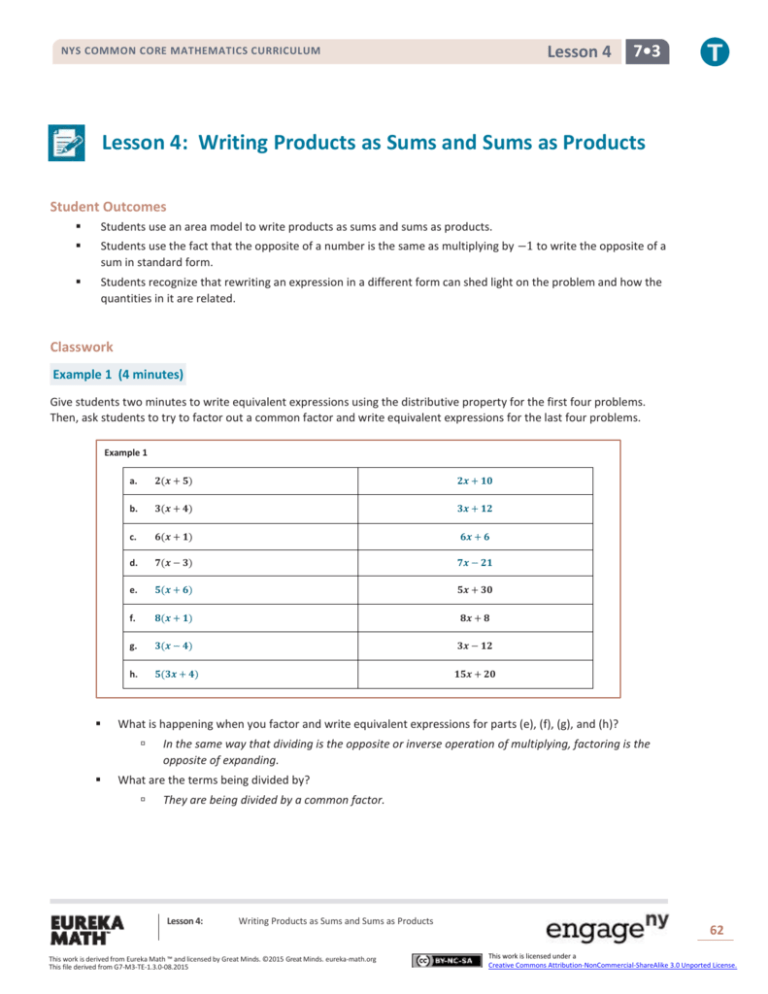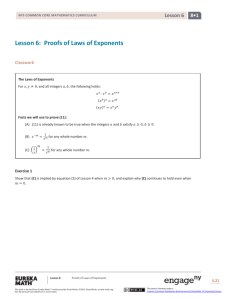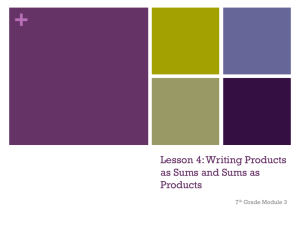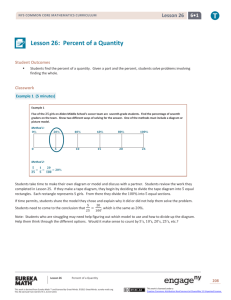G7-M3 Lesson 4
advertisement

Lesson 4 NYS COMMON CORE MATHEMATICS CURRICULUM 7•3 Lesson 4: Writing Products as Sums and Sums as Products Student Outcomes Students use an area model to write products as sums and sums as products. Students use the fact that the opposite of a number is the same as multiplying by −1 to write the opposite of a sum in standard form. Students recognize that rewriting an expression in a different form can shed light on the problem and how the quantities in it are related. Classwork Example 1 (4 minutes) Give students two minutes to write equivalent expressions using the distributive property for the first four problems. Then, ask students to try to factor out a common factor and write equivalent expressions for the last four problems. Example 1 a. 𝟐(𝒙 + 𝟓) 𝟐𝒙 + 𝟏𝟎 b. 𝟑(𝒙 + 𝟒) 𝟑𝒙 + 𝟏𝟐 c. 𝟔(𝒙 + 𝟏) 𝟔𝒙 + 𝟔 d. 𝟕(𝒙 − 𝟑) 𝟕𝒙 − 𝟐𝟏 e. 𝟓(𝒙 + 𝟔) 𝟓𝒙 + 𝟑𝟎 f. 𝟖(𝒙 + 𝟏) 𝟖𝒙 + 𝟖 g. 𝟑(𝒙 − 𝟒) 𝟑𝒙 − 𝟏𝟐 h. 𝟓(𝟑𝒙 + 𝟒) 𝟏𝟓𝒙 + 𝟐𝟎 What is happening when you factor and write equivalent expressions for parts (e), (f), (g), and (h)? In the same way that dividing is the opposite or inverse operation of multiplying, factoring is the opposite of expanding. What are the terms being divided by? They are being divided by a common factor. Lesson 4: Writing Products as Sums and Sums as Products This work is derived from Eureka Math ™ and licensed by Great Minds. ©2015 Great Minds. eureka-math.org This file derived from G7-M3-TE-1.3.0-08.2015 62 This work is licensed under a Creative Commons Attribution-NonCommercial-ShareAlike 3.0 Unported License. Lesson 4 NYS COMMON CORE MATHEMATICS CURRICULUM 7•3 Have students write an expression that is equivalent to 8𝑥 + 4. Would it be incorrect to factor out a 2 instead of a 4? It would not be incorrect, but in order to factor completely, we would need to factor out another 2. 8𝑥 + 4 Commutative property 4(2𝑥) + 4(1) Equivalent expression 4(2𝑥 + 1) Distributive property Exercise 1 (3 minutes) Students work independently and share their answers with a partner. Discuss together as a class. Exercise 1 Rewrite the expressions as a product of two factors. 𝟕𝟐𝒕 + 𝟖 a. c. 𝟖(𝟗𝒕 + 𝟏) 𝟓𝟓𝒂 + 𝟏𝟏 b. 𝟑𝟔𝒛 + 𝟕𝟐 e. 𝟑𝟔(𝒛 + 𝟐) d. 𝟏𝟏(𝟓𝒂 + 𝟏) 𝟑𝒓 + 𝟑𝒔 𝟑(𝒓 + 𝒔) 𝟏𝟒𝟒𝒒 − 𝟏𝟓 𝟑(𝟒𝟖𝒒 − 𝟓) Example 2 (5 minutes) In this example, let the variables 𝑥 and 𝑦 stand for positive integers, and let 2𝑥, 12𝑦, and 8 represent the area of three rectangles. The goal is to find the lengths of each individual region with areas of 2𝑥, 12𝑦, and 8, so that all three regions have the same width. Let students explore different possibilities. Example 2 Let the variables 𝒙 and 𝒚 stand for positive integers, and let 𝟐𝒙, 𝟏𝟐𝒚, and 𝟖 represent the area of three regions in the array. Determine the length and width of each rectangle if the width is the same for each rectangle. 𝟐𝒙 𝟖 What does 2𝑥 represent in the first region of the array? 𝟏𝟐𝒚 The region has an area of 2𝑥 or can be covered by 2𝑥 square units. What does the entire array represent? The entire array represents 2𝑥 + 12𝑦 + 8 square units. Lesson 4: Writing Products as Sums and Sums as Products This work is derived from Eureka Math ™ and licensed by Great Minds. ©2015 Great Minds. eureka-math.org This file derived from G7-M3-TE-1.3.0-08.2015 63 This work is licensed under a Creative Commons Attribution-NonCommercial-ShareAlike 3.0 Unported License. Lesson 4 NYS COMMON CORE MATHEMATICS CURRICULUM What is the common factor of 2𝑥, 12𝑦, and 8? 7•3 The common factor of 2𝑥, 12𝑦, and 8 is 2. What are the missing values, and how do you know? The missing values are 𝑥, 6𝑦, and 4. If the products are given in the area of the regions, divide the regions by 2 to determine the missing values. 𝒙 𝟔𝒚 𝟒 𝟐 Write the expression as a sum and then as a product of two factors. 2𝑥 + 12𝑦 + 8 2(𝑥 + 6𝑦 + 4) How does this exercise differ from the exercises we did during the previous lesson? How is this exercise similar to the ones we did during the previous lesson? We are doing the inverse of writing products as sums. Before, we wrote a product as a sum using the distributive property. Now, we are writing a sum as a product using the distributive property. Exercise 2 (3 minutes) Have students work on the following exercise individually and discuss the results as a class. Exercise 2 a. Write the product and sum of the expressions being represented in the rectangular array. 𝟐(𝟏𝟐𝒅 + 𝟒𝒆 + 𝟑), 𝟐𝟒𝒅 + 𝟖𝒆 + 𝟔 b. Factor 𝟒𝟖𝒋 + 𝟔𝟎𝒌 + 𝟐𝟒 by finding the greatest common factor of the terms. 𝟏𝟐(𝟒𝒋 + 𝟓𝒌 + 𝟐) Lesson 4: Writing Products as Sums and Sums as Products This work is derived from Eureka Math ™ and licensed by Great Minds. ©2015 Great Minds. eureka-math.org This file derived from G7-M3-TE-1.3.0-08.2015 64 This work is licensed under a Creative Commons Attribution-NonCommercial-ShareAlike 3.0 Unported License. Lesson 4 NYS COMMON CORE MATHEMATICS CURRICULUM 7•3 Exercise 3 (4 minutes) Exercise 3 For each expression, write each sum as a product of two factors. Emphasize the importance of the distributive property. Use various equivalent expressions to justify equivalency. a. 𝟐∙𝟑+𝟓∙𝟑 b. 𝒙∙𝟑+𝟓∙𝟑 c. This expression is 𝟑 groups of (𝟐 + 𝟓) or 𝟑(𝟐) + 𝟑(𝟓), which is 𝟑(𝟐 + 𝟓). Both have a common factor of 𝟑, so the two factors would be 𝟑(𝟐 + 𝟓). Demonstrate that 𝟑(𝟕) is equivalent to 𝟔 + 𝟏𝟓, or 𝟐𝟏. d. (𝟐 + 𝟓) + (𝟐 + 𝟓) + (𝟐 + 𝟓) e. (𝒙 + 𝟓) + (𝒙 + 𝟓) + (𝒙 + 𝟓) Rewrite the expression as 𝟐 ∙ 𝟐 + (𝟓 ∙ 𝟐) + (𝟐 + 𝟓), so 𝟐(𝟐 + 𝟓) + (𝟐 + 𝟓), which equals 𝟑(𝟐 + 𝟓). f. Similar to part (b), this is 𝟑 groups of (𝒙 + 𝟓), so 𝟑(𝒙 + 𝟓). The greatest common factor is 𝟑, so factor out the 𝟑: 𝟑(𝒙 + 𝟓). 𝟐 ∙ 𝟐 + (𝟓 + 𝟐) + (𝟓 ∙ 𝟐) 𝟐𝒙 + (𝟓 + 𝒙) + 𝟓 ∙ 𝟐 Combine like terms and then identify the common factor. 𝟑𝒙 + 𝟏𝟓, where 𝟑 is the common factor: 𝟑(𝒙 + 𝟓). Or, 𝟐𝒙 + 𝟐 ∙ 𝟓 + (𝒙 + 𝟓), so that 𝟐(𝒙 + 𝟓) + (𝒙 + 𝟓) = 𝟑(𝒙 + 𝟓). Or, use the associative property and write: 𝟐𝒙 + (𝟓 ⋅ 𝟐) + (𝟓 + 𝒙) 𝟐(𝒙 + 𝟓) + (𝟓 + 𝒙) 𝟑(𝒙 + 𝟓). g. 𝒙∙𝟑+𝒚∙𝟑 h. The greatest common factor is 𝟑, so 𝟑(𝒙 + 𝒚). (𝒙 + 𝒚) + (𝒙 + 𝒚) + (𝒙 + 𝒚) There are 𝟑 groups of (𝒙 + 𝒚), so 𝟑(𝒙 + 𝒚). i. 𝟐𝒙 + (𝒚 + 𝒙) + 𝟐𝒚 Combine like terms and then identify the common factor. 𝟑𝒙 + 𝟑𝒚, where 𝟑 is the common factor. 𝟑(𝒙 + 𝒚). Or, 𝟐𝒙 + 𝟐𝒚 + (𝒙 + 𝒚), so that 𝟐(𝒙 + 𝒚) + (𝒙 + 𝒚) is equivalent to 𝟑(𝒙 + 𝒚). Or, use the associative property, and write: 𝟐𝒙 + 𝟐𝒚 + (𝒚 + 𝒙) 𝟐(𝒙 + 𝒚) + (𝒙 + 𝒚) 𝟑(𝒙 + 𝒚). Lesson 4: Writing Products as Sums and Sums as Products This work is derived from Eureka Math ™ and licensed by Great Minds. ©2015 Great Minds. eureka-math.org This file derived from G7-M3-TE-1.3.0-08.2015 65 This work is licensed under a Creative Commons Attribution-NonCommercial-ShareAlike 3.0 Unported License. Lesson 4 NYS COMMON CORE MATHEMATICS CURRICULUM 7•3 Example 3 (4 minutes) Allow students to read the problem and address the task individually. Share student responses as a class. Example 3 A new miniature golf and arcade opened up in town. For convenient ordering, a play package is available to purchase. It includes two rounds of golf and 𝟐𝟎 arcade tokens, plus $𝟑. 𝟎𝟎 off the regular price. There is a group of six friends purchasing this package. Let 𝒈 represent the cost of a round of golf, and let 𝒕 represent the cost of a token. Write two different expressions that represent the total amount this group spent. Explain how each expression describes the situation in a different way. What two equivalent expressions could be used to represent the situation? 6(2𝑔 + 20𝑡 − 3) Each person will pay for two rounds of golf and 20 tokens and will be discounted $3.00. This expression is six times the quantity of each friend’s cost. 12𝑔 + 120𝑡 − 18 The total cost is equal to 12 games of golf plus 120 tokens, minus $18.00 off the entire bill. Example 4 (3 minutes) What does it mean to take the opposite of a number? You can determine the additive inverse of a number or a multiplicative inverse. What is the opposite of 2? −2 What is (−1)(2)? What is (−1)(𝑛)? (−1)(2𝑎 + 3𝑏) or −(2𝑎 + 3𝑏) Use the distributive property to write (−1)(2𝑎 + 3𝑏) as an equivalent expression. −𝑛 What are two mathematical expressions that represent the opposite of (2𝑎 + 3𝑏)? −2 −2𝑎 − 3𝑏 or −2𝑎 + (−3𝑏) To go from −2𝑎 − 3𝑏 to −(2𝑎 + 3𝑏), what process occurs? The terms −2𝑎 and −3𝑏 are written as (−1)(2𝑎) and (−1)(3𝑏), and the −1 is factored out of their sum. Lesson 4: Writing Products as Sums and Sums as Products This work is derived from Eureka Math ™ and licensed by Great Minds. ©2015 Great Minds. eureka-math.org This file derived from G7-M3-TE-1.3.0-08.2015 66 This work is licensed under a Creative Commons Attribution-NonCommercial-ShareAlike 3.0 Unported License. Lesson 4 NYS COMMON CORE MATHEMATICS CURRICULUM 7•3 Exercise 4 (3 minutes) Exercise 4 a. What is the opposite of (−𝟔𝒗 + 𝟏)? −(−𝟔𝒗 + 𝟏) b. Using the distributive property, write an equivalent expression for part (a). 𝟔𝒗 − 𝟏 Example 5 (3 minutes) With the class, rewrite 5𝑎 − (𝑎 − 3𝑏) applying the rules for subtracting and Example 2. Example 5 Rewrite 𝟓𝒂 − (𝒂 − 𝟑𝒃) in standard form. Justify each step, applying the rules for subtracting and the distributive property. 𝟓𝒂 + (−(𝒂 + −𝟑𝒃)) Subtraction as adding the inverse 𝟓𝒂 + (−𝟏)(𝒂 + −𝟑𝒃) The opposite of a number is the same as multiplying by – 𝟏. 𝟓𝒂 + (−𝟏)(𝒂) + (−𝟏)(−𝟑𝒃) Distributive property 𝟓𝒂 + −𝒂 + 𝟑𝒃 Multiplying by −𝟏 is the same as the opposite of the number. 𝟒𝒂 + 𝟑𝒃 Collect like terms Exercise 5 (7 minutes) Encourage students to work with partners to expand each expression and collect like terms while applying the rules of subtracting and the distributive property. Exercise 5 Expand each expression and collect like terms. a. b. −𝟑(𝟐𝒑 − 𝟑𝒒) −𝟑(𝟐𝒑 + (−𝟑𝒒)) Subtraction as adding the inverse −𝟑 ∙ 𝟐𝒑 + (−𝟑) ∙ (−𝟑𝒒) Distributive property −𝟔𝒑 + 𝟗𝒒 Apply integer rules −𝒂 − (𝒂 − 𝒃) −𝒂 + (−(𝒂 + −𝒃)) Subtraction as adding the inverse −𝟏𝒂 + (−𝟏(𝒂 + −𝟏𝒃)) The opposite of a number is the same as multiplying by – 𝟏. −𝟏𝒂 + (−𝟏𝒂) + 𝟏𝒃 Distributive property −𝟐𝒂 + 𝒃 Apply integer addition rules Lesson 4: Writing Products as Sums and Sums as Products This work is derived from Eureka Math ™ and licensed by Great Minds. ©2015 Great Minds. eureka-math.org This file derived from G7-M3-TE-1.3.0-08.2015 67 This work is licensed under a Creative Commons Attribution-NonCommercial-ShareAlike 3.0 Unported License. NYS COMMON CORE MATHEMATICS CURRICULUM Lesson 4 7•3 Closing (2 minutes) In writing products as sums, what is happening when you take the opposite of a term or factor? The term or factor is multiplied by −1. When using the distributive property, every term inside the parentheses is multiplied by −1. Describe the process you used to write an expression in the form of the sum of terms as an equivalent expression in the form of a product of factors. Writing sums as products is the opposite of writing products as sums; so, instead of distributing and multiplying, the product is being factored. Exit Ticket (4 minutes) Lesson 4: Writing Products as Sums and Sums as Products This work is derived from Eureka Math ™ and licensed by Great Minds. ©2015 Great Minds. eureka-math.org This file derived from G7-M3-TE-1.3.0-08.2015 68 This work is licensed under a Creative Commons Attribution-NonCommercial-ShareAlike 3.0 Unported License. NYS COMMON CORE MATHEMATICS CURRICULUM Name ___________________________________________________ Lesson 4 7•3 Date____________________ Lesson 4: Writing Products as Sums and Sums as Products Exit Ticket 1. Write the expression below in standard form. 3ℎ − 2(1 + 4ℎ) 2. Write the expression below as a product of two factors. 6𝑚 + 8𝑛 + 4 Lesson 4: Writing Products as Sums and Sums as Products This work is derived from Eureka Math ™ and licensed by Great Minds. ©2015 Great Minds. eureka-math.org This file derived from G7-M3-TE-1.3.0-08.2015 69 This work is licensed under a Creative Commons Attribution-NonCommercial-ShareAlike 3.0 Unported License. Lesson 4 NYS COMMON CORE MATHEMATICS CURRICULUM 7•3 Exit Ticket Sample Solutions 1. Write the expression below in standard form. 𝟑𝒉 − 𝟐(𝟏 + 𝟒𝒉) 2. 𝟑𝒉 + (−𝟐(𝟏 + 𝟒𝒉)) Subtraction as adding the inverse 𝟑𝒉 + (−𝟐 ∙ 𝟏) + (−𝟐𝒉 ∙ 𝟒) Distributive property 𝟑𝒉 + (−𝟐) + (−𝟖𝒉) Apply integer rules −𝟓𝒉 − 𝟐 Collect like terms Write the expression below as a product of two factors. 𝟔𝒎 + 𝟖𝒏 + 𝟒 The GCF for the terms is 𝟐. Therefore, the factors are 𝟐(𝟑𝒎 + 𝟒𝒏 + 𝟐). Problem Set Sample Solutions 1. Write each expression as the product of two factors. a. 𝟏∙𝟑+𝟕∙𝟑 b. 𝟑(𝟏 + 𝟕) d. 𝒉∙𝟑+𝟔∙𝟑 𝒋∙𝟑+𝒌∙𝟑 e. (𝒉 + 𝟔) + (𝒉 + 𝟔) + (𝒉 + 𝟔) h. (𝒋 + 𝒌) + (𝒋 + 𝒌) + (𝐣 + 𝐤) 𝟐 ∙ 𝟏 + (𝟏 + 𝟕) + (𝟕 ∙ 𝟐) 𝟑(𝟏 + 𝟕) f. 𝟑(𝒉 + 𝟔) 𝟑(𝒋 + 𝒌) 2. c. 𝟑(𝟏 + 𝟕) 𝟑(𝒉 + 𝟔) g. (𝟏 + 𝟕) + (𝟏 + 𝟕) + (𝟏 + 𝟕) 𝟐𝒉 + (𝟔 + 𝒉) + 𝟔 ∙ 𝟐 𝟑(𝒉 + 𝟔) i. 𝟑(𝒋 + 𝒌) 𝟐𝒋 + (𝒌 + 𝒋) + 𝟐𝒌 𝟑(𝒋 + 𝒌) Write each sum as a product of two factors. a. 𝟔∙𝟕+𝟑∙𝟕 b. 𝟕(𝟔 + 𝟑) d. 𝟐𝒚 ∙ 𝟑 + 𝟒 ∙ 𝟑 𝒇∙𝟔+𝒈∙𝟔 𝟔(𝒇 + 𝒈) Lesson 4: c. 𝟑(𝟖 + 𝟗) e. 𝟑(𝟐𝒚 + 𝟒) g. (𝟖 + 𝟗) + (𝟖 + 𝟗) + (𝟖 + 𝟗) (𝒙 + 𝟓) + (𝒙 + 𝟓) 𝟒(𝟏 + 𝟒 + 𝟓) f. 𝟐(𝒙 + 𝟓) h. (𝒄 + 𝒅) + (𝒄 + 𝒅) + (𝒄 + 𝒅) + (𝒄 + 𝒅) 𝟒(𝒄 + 𝒅) Writing Products as Sums and Sums as Products This work is derived from Eureka Math ™ and licensed by Great Minds. ©2015 Great Minds. eureka-math.org This file derived from G7-M3-TE-1.3.0-08.2015 𝟒 + (𝟏𝟐 + 𝟒) + (𝟓 ∙ 𝟒) 𝟑𝒙 + (𝟐 + 𝒙) + 𝟓 ∙ 𝟐 𝟒(𝒙 + 𝟑) i. 𝟐𝒓 + 𝒓 + 𝒔 + 𝟐𝒔 𝟑(𝒓 + 𝒔) 70 This work is licensed under a Creative Commons Attribution-NonCommercial-ShareAlike 3.0 Unported License. Lesson 4 NYS COMMON CORE MATHEMATICS CURRICULUM 3. 7•3 Use the following rectangular array to answer the questions below. a. Fill in the missing information. 𝟑𝒇 𝒈 𝟗 𝟓 b. Write the sum represented in the rectangular array. 𝟏𝟓𝒇 + 𝟓𝒈 + 𝟒𝟓 c. Use the missing information from part (a) to write the sum from part (b) as a product of two factors. 𝟓(𝟑𝒇 + 𝒈 + 𝟗) 4. Write the sum as a product of two factors. a. 𝟖𝟏𝒘 + 𝟒𝟖 𝟑(𝟐𝟕𝒘 + 𝟏𝟔) b. 𝟏𝟎 − 𝟐𝟓𝒕 𝟓(𝟐 − 𝟓𝒕) c. 𝟏𝟐𝒂 + 𝟏𝟔𝒃 + 𝟖 𝟒(𝟑𝒂 + 𝟒𝒃 + 𝟐) 5. Xander goes to the movies with his family. Each family member buys a ticket and two boxes of popcorn. If there are five members of his family, let 𝒕 represent the cost of a ticket and 𝒑 represent the cost of a box of popcorn. Write two different expressions that represent the total amount his family spent. Explain how each expression describes the situation in a different way. 𝟓(𝒕 + 𝟐𝒑) Five people each buy a ticket and two boxes of popcorn, so the cost is five times the quantity of a ticket and two boxes of popcorn. 𝟓𝒕 + 𝟏𝟎𝒑 There are five tickets and 𝟏𝟎 boxes of popcorn total. The total cost will be five times the cost of the tickets, plus 𝟏𝟎 times the cost of the popcorn. Lesson 4: Writing Products as Sums and Sums as Products This work is derived from Eureka Math ™ and licensed by Great Minds. ©2015 Great Minds. eureka-math.org This file derived from G7-M3-TE-1.3.0-08.2015 71 This work is licensed under a Creative Commons Attribution-NonCommercial-ShareAlike 3.0 Unported License. NYS COMMON CORE MATHEMATICS CURRICULUM 6. Lesson 4 7•3 Write each expression in standard form. a. −𝟑(𝟏 − 𝟖𝒎 − 𝟐𝒏) −𝟑(𝟏 + (−𝟖𝒎) + (−𝟐𝒏)) −𝟑 + 𝟐𝟒𝒎 + 𝟔𝒏 b. 𝟓 − 𝟕(−𝟒𝒒 + 𝟓) 𝟓 + −𝟕(−𝟒𝒒 + 𝟓) 𝟓 + 𝟐𝟖𝒒 + (−𝟑𝟓) 𝟐𝟖𝒒 − 𝟑𝟓 + 𝟓 𝟐𝟖𝒒 − 𝟑𝟎 c. −(𝟐𝒉 − 𝟗) − 𝟒𝒉 −(𝟐𝒉 + (−𝟗)) + (−𝟒𝒉) −𝟐𝒉 + 𝟗 + (−𝟒𝒉) −𝟔𝒉 + 𝟗 d. 𝟔(−𝟓𝒓 − 𝟒) − 𝟐(𝒓 − 𝟕𝒔 − 𝟑) 𝟔(−𝟓𝒓 + −𝟒) + −𝟐(𝒓 − 𝟕𝒔 + −𝟑) −𝟑𝟎𝒓 + −𝟐𝟒 + −𝟐𝒓 + 𝟏𝟒𝒔 + 𝟔 −𝟑𝟎𝒓 + −𝟐𝒓 + 𝟏𝟒𝒔 + −𝟐𝟒 + 𝟔 −𝟑𝟐𝒓 + 𝟏𝟒𝒔 − 𝟏𝟖 7. Combine like terms to write each expression in standard form. a. (𝒓 − 𝒔) + (𝒔 − 𝒓) 𝟎 b. (−𝒓 + 𝒔) + (𝒔 − 𝒓) −𝟐𝒓 + 𝟐𝒔 c. (−𝒓 − 𝒔) − (−𝒔 − 𝒓) 𝟎 d. (𝒓 − 𝒔) + (𝒔 − 𝒕) + (𝒕 − 𝒓) 𝟎 e. (𝒓 − 𝒔) − (𝒔 − 𝒕) − (𝒕 − 𝒓) 𝟐𝒓 − 𝟐𝒔 Lesson 4: Writing Products as Sums and Sums as Products This work is derived from Eureka Math ™ and licensed by Great Minds. ©2015 Great Minds. eureka-math.org This file derived from G7-M3-TE-1.3.0-08.2015 72 This work is licensed under a Creative Commons Attribution-NonCommercial-ShareAlike 3.0 Unported License.









